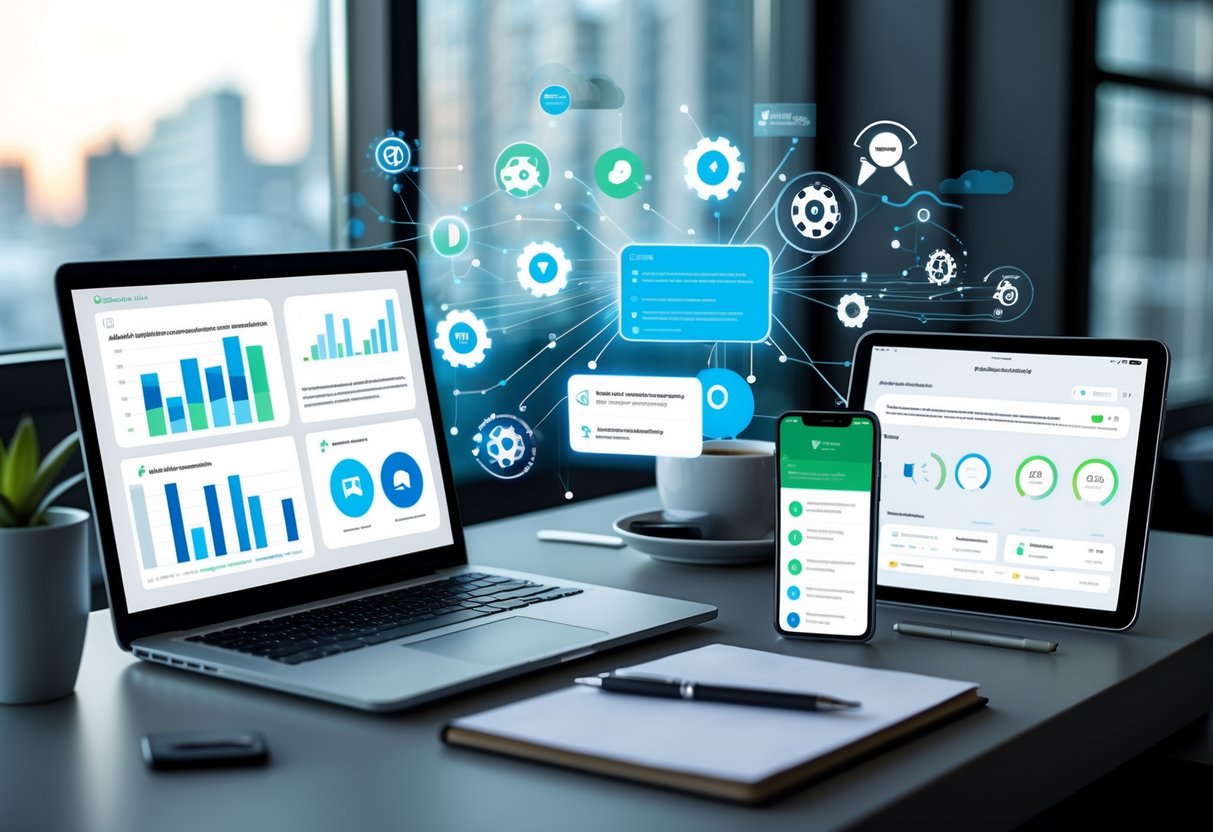When questions start rolling in at all hours, it’s overwhelming. I get it—replying to every inquiry while juggling a million other things? Not easy.
Inquiry response automation lets you answer fast, every time, and without piling on extra work.

With automated replies up and running, every inquiry gets an instant acknowledgment, even if I’m away. Tools with pre-built templates, triggers, and AI-driven personalization keep my communication sharp and professional.
This saves a ton of time. People notice the difference in support—it’s just smoother.
I can cut delays, handle common questions on autopilot, and give my focus to trickier stuff that really needs a human. The setup’s pretty simple, honestly, but it changes the whole game for managing messages.
Key Takeaways
- Automation means replies go out lightning fast and always sound consistent.
- Smart tools take care of the boring stuff, so I don’t have to.
- Clear, reliable strategies build trust and keep clients happy.
What Is Inquiry Response Automation?
I use inquiry response automation to handle customer messages quickly and reliably. It cuts out manual work, boosts customer satisfaction, and makes sure nobody gets ignored.
Definition and Core Concepts
Inquiry response automation is just using software or AI to reply to incoming questions automatically. These systems shoot out instant “got your message” emails, answer FAQs, or send tricky stuff to the right teammate.
I see it as a mix of automation rules and ready-made workflows. Say, someone emails about shipping—boom, they get a confirmation, and later, a detailed update.
Modern tools plug right into CRM systems, chat apps, or email parsers. That way, I can track all the back-and-forth in one spot. With AI-driven inquiry automation, I can even make my replies feel personal without slowing down.
Benefits for Businesses and Customers
Speed is the big win. Automated replies let people know I’m on it—even a quick note builds trust.
For businesses, automation means less staff time wasted on repetitive stuff. Response times drop, and efficiency goes up. Best practices in automated email response show that quick acknowledgments actually boost customer satisfaction scores.
Customers love it, too. They get consistent info, no matter what time it is. If there’s a knowledge base, sometimes they find answers without needing more help.
If you’re running a business, why not let automation handle the basics? It frees you up for the stuff that really matters.
Common Use Cases
I use inquiry response automation for a bunch of things. Sending confirmation emails is a big one—people want to know their message landed.
Handling frequently asked questions is another. With a solid library of standard replies, I can answer stuff about billing, returns, or product details without lifting a finger.
When things get busy, automation helps me keep up. Tools like automated customer service responses let me send quick replies, route messages, and focus on the weird or complicated cases.
And for leads? Automation paired with CRM means every new inquiry gets a fast response, details get captured, and follow-ups are assigned. Everything stays organized.
Honestly, if you want to skip all the hassle and just get high-quality leads or advice on setting this up, feel free to contact me on Whatsapp at +917303556188. Why do all the heavy lifting yourself?
Key Components of Inquiry Response Automation
I focus on three main things: using templates, handling form submissions smoothly, and syncing everything with my CRM. Each piece cuts down the manual grind and keeps replies on point.
Automated Email Templates
I lean on automated email templates to keep messages consistent and professional. Templates save me from rewriting the same stuff and let me pop in details like the customer’s name or order number.
Templates mean less typing, fewer mistakes, and a steady tone across my team. I set up templates for:
- Acknowledging inquiries (auto-reply, done)
- FAQs (shipping, returns, setup—whatever pops up a lot)
- Escalations (when it’s time for a real person to jump in)
With templates, I answer faster and keep people in the loop. It’s efficient, but still feels personal when I need it to.
Form Submission Handling
Forms are where a lot of questions start. I automate the capture and routing so nothing gets lost in a messy inbox.
The system grabs key info—contact details, what the inquiry’s about, how urgent it is. It then triggers the right workflow.
A product return form, for example, can create a case number, send a confirmation, and route it straight to the returns team. Technical support forms might suggest a help article before escalating.
Automating forms means less sorting for me and quicker replies for customers. Everyone wins.
Integration With CRM Systems
I hook up my inquiry automation with CRM systems so all customer interactions stay in one place. This lets me pull up order history, past tickets, and other details right into my replies.
When automation tools can see CRM data, replies get way more personal and accurate. Instead of a bland update, the system can mention the customer’s last purchase or subscription.
Integration also helps me track how I’m doing—response times, resolution rates, satisfaction. I can tweak things as I go to make service even better.
Combining automation with CRM just makes the whole process smoother. No more duplicate work, and customers notice the difference.
How Inquiry Response Automation Improves Response Times

Automation wipes out delays from manual steps, gets messages to the right person fast, and makes it super easy to spot and fix slowdowns. That means customers get answers way quicker.
Reducing Manual Workflows
When I automate, I stop wasting time typing the same answers or sorting basic questions. Automated systems fire off pre-approved replies instantly.
This is a lifesaver after hours or during busy spells. Automated inquiry response tools use triggers to send the perfect message, no human needed.
I see fewer errors, too. Everyone gets the right info, every time. Less manual work equals faster replies and more time for tricky stuff.
Real-Time Routing and Alerts
Automation routes messages to the right spot the second they come in. No more waiting for someone to sort them.
AI-driven tools can figure out if a question’s simple and send an instant reply. If it’s complicated, it goes straight to the person who can help.
If something sits too long, the system pings me or my team. No more missed emails or forgotten requests.
Measuring and Optimizing Response Times
I keep an eye on how fast I’m replying. I track average response time, first reply time, and how long it takes to solve things.
Automation tools come with dashboards showing these numbers live. AI response automation platforms even spot trends so I can tweak templates or routing rules.
Over time, this just keeps making things faster and more reliable for everyone.
Popular Tools and Platforms for Automation

I pick different tools depending on what I need—sometimes it’s simple task automation, other times it’s AI for smarter replies, or even custom setups for unique workflows.
Zapier for Workflow Automation
Zapier is my go-to for connecting apps and automating boring tasks without coding. It works with thousands of apps, from Gmail to Slack to Google Sheets.
With Zapier, I set up “Zaps”—so if a new form comes in, it can send an email or log data automatically.
It’s perfect for simple workflows. Popular workflow automation tools in 2025 still put Zapier at the top because it’s easy and reliable.
For inquiry responses, I use Zapier to route messages, send auto-replies, and keep data in sync. Fast, dependable, and no headaches.
AI-Powered Solutions
For more advanced stuff, I like AI-powered platforms. They understand context, can sense the customer’s mood, and write more natural replies.
ChatGPT for Business generates smart answers and plugs into ticketing systems. Zoho Desk AI and Intercom’s Resolution Bot do automated replies and pass tough cases to real people.
AI tools shine when you’ve got a flood of messages. They keep things personal, even at scale.
Platforms like Thunderbit mix workflow automation with AI, so you get both structure and smarter decision-making.
Custom Integrations
Sometimes I need more flexibility than standard tools offer. That’s when I build custom integrations with APIs or low-code platforms.
Make and n8n let me design complex workflows and connect apps that Zapier can’t. I use these for syncing customer records or handling special data flows.
Automation software reviews say these platforms are favorites for teams who want visual control over every step.
Custom setups take a bit more work upfront, but they’re worth it if you want something tailored and scalable.
If this sounds complicated or you just want to skip straight to getting leads or advice, seriously, just message me on Whatsapp at +917303556188. It’s easier to buy from someone who’s done all the hard work already.
Best Practices for Maximizing Customer Satisfaction

Building trust comes down to clear communication, quick replies, and knowing when to let a real person step in. I focus on these to keep customers happy and things running smooth.
Personalization Strategies
I make sure automated replies don’t sound like robots. Using the customer’s name, order number, or details about their situation makes a real difference.
I also segment customers. First-timers get different messages than regulars—no copy-paste approach here.
When it helps, I add self-service resources like FAQs or troubleshooting guides. But I only include links that actually fit the customer’s problem.
If you’re tired of wrestling with automation setups or just want quality leads without the hassle, feel free to contact me on Whatsapp: +917303556188. Honestly, it’s easier to let someone else handle it, right?
Maintaining Consistency and Quality
I keep my automated responses steady in tone and format. Accuracy matters, so I double-check templates and tweak them often.
Customers expect a professional vibe every time. That’s why I set up email templates and make sure they stay fresh.
I let people know what comes next—timelines, next steps, maybe even escalation options. If I say when a support agent will follow up, folks feel less anxious.
Over-automation? Not my thing. If something’s complicated or touchy, I jump in personally. Automation’s great, but sometimes you just need a human touch.
Honestly, using tools like automated email responses for customer service saves me time. It keeps things consistent and lets me focus on the trickier stuff.
If you’re tired of the hassle and want leads or help setting up automation, just WhatsApp me at +917303556188. Seriously, why do all this yourself when I’ve already got it down? Feel free to reach out—no pressure, just real results.
Continuous Improvement and Feedback
I watch open rates, response times, and satisfaction scores. These numbers tell me if my system’s working or if something needs fixing.
Getting feedback is crucial. I send out quick surveys or follow-up emails to see what people think.
If someone says instructions are unclear, I fix the template right away. No point in letting confusion pile up.
I ditch outdated or repetitive messages fast. Sometimes I try new subject lines or tweak the tone just to see what lands better.
Frequently Asked Questions
I design response systems to save time and cut down on manual work. The goal? Consistency and less stress for everyone.
How can I create an effective inquiry response automation template?
First, I map out the most common questions. Then I write clear, direct answers.
Simple language works best. I add links or next steps if needed.
What are some best practices for setting up automated email responses?
Keep it short and relevant. Confirm you got the inquiry, set a realistic response time, and toss in helpful resources if you can.
I always aim for a conversational tone—no cold, robotic stuff.
What tools are available for automating responses to inquiries?
There are plenty—email marketing platforms, help desk systems, AI chatbots.
Platforms like Yellow.ai FAQ chatbots and Veeva response automation handle lots of questions at once. They work nicely with websites, CRMs, and messaging apps.
How do I personalize automated email responses to improve customer engagement?
I use the customer’s name, mention their specific request, and match my tone to my brand.
Sharing links that actually help makes the message feel personal, not canned.
Can automated responses be integrated with customer relationship management systems?
Absolutely. I connect automation tools with CRM platforms to sync up customer data.
This way, I can track inquiries, update records, and keep communication smooth across every channel.
If you want to skip the trial and error, just ping me on WhatsApp at +917303556188. Buying leads or getting set up is way easier with someone who’s done it before. Feel free to contact me anytime—you’ll probably wonder why you didn’t do it sooner.
What metrics should I track to evaluate the success of my inquiry response automation?
Honestly, I keep an eye on response time and how fast I can get back to people. Resolution rate matters too—are folks actually getting their issues sorted out?
Customer satisfaction scores give me a sense of whether people are happy with the replies. I also notice if people are clicking on the links or resources I send over.
If I start getting fewer repeat questions, that tells me my templates must be doing something right. But let’s be real—why spend hours figuring this all out yourself?
If you want to save time and just get leads that actually convert, feel free to contact me on WhatsApp at +917303556188. I’d be happy to chat about consultation or send you quality leads. Sometimes, it’s just easier to let someone else handle the heavy lifting.



